|
Chapter Seven
THE DAY THE SUN
STOOD STILL
"The first wave of priests accompanying the conquerors was bent on
destroying everything that had to do with the Indiansí "idolatry."
"....The realization that the Andean Indians believed in a Supreme
Creator and that their legends recalled the Deluge, increased the
curiosity of the Spanish priests (which followed after the first
priests).
"....As in Mexico, after various other ancients peoples have been
considered, the Israelites of the Ten Lost Tribes seemed the most
plausible explanation not only for the similarity of native legends
to biblical tales, but also to such customs among the Peruvian
Indians as the offering of the first fruits, and Expiation Feast at
the end of September that corresponded to the nature and time of the
Jewish day of Atonement, and other biblical commandments such as the
rite of circumcision, abstaining from the blood of animal meat, and
the prohibition against the eating of fish without scales. In the
Feast of First Fruits, the Indians chanted the mystic words
Yo
Meshica, He Meshica, Va Meshica; and some of the Spanish savants
discerned in the word Meshica the Hebrew term "Mashiíach" -
the
Messiah.
Other terms were compared by scholars:
Ira Andean, compared to
Mesopotamian Ira/Illa, from which the
Mesopotamian El stems. Malquis Inca, compared to
Canaanite Molekh (Lord), likewise Manco
from the same Semitic root, meaning "king."
"It was in view of such theories of Israelite-biblical origins that
the Catholic hierarchy in Peru, after the initial wave of
obliteration, moved to record and preserve the Indian heritage.
"Picking up a common point of departure in biblical and Andean
recollections - the tale of the Deluge - Montesinos employed the
event (Montesinos was a Spaniard who arrived in Peru in 1628 and
devoted the rest of his life to the compilation of a comprehensive
and chronological history and prehistory of the Peruvians), as his
starting point. In line with the biblical record he followed the
repopulation of Earth after the Deluge from Mount Ararat in Armenia
through the
Table of Nations in Chapter 10 of the book of
Genesis.
He saw in the name Peru (or Piru/Pirua in the Indian tongue) a
phonetic rendering of the name Ophir, the grandson of Eber (the
forebear of the Hebrews) who himself was the great-grandson of Shem.
Ophir was also the name of the famed Land of Gold from which the
Phoenicians had brought gold for the temple in Jerusalem that
King
Solomon was building.... Havilah (Ophirís brother) was also another
name for the land of gold.
"....It was much before the times of the kingdoms of
Judah and
Israel, much before the Ten Tribes were exiled by the
Assyrians,
that peoples from the lands of the Bible had come to the Andes,
Montesinos theorized....
"The Inca tales
Montesinos assembled, attested that long before the
latest Inca dynasty there had been an ancient empire. After a period
of growth and prosperity upheavals suddenly befell the land.... wars
broke out. The king reigning at the time left Cuzco and led his
followers to a secluded refuge place in the mountains called
Tampu-Tocco; only a few priests remained in Cuzco to maintain its
shrine. It was during that calamitous time that the art of writing
was lost.
"Centuries passed. The kings went periodically from
Tampu-Tocco to
Cuzco to consult divine oracles. Then one day a woman of noble birth
appeared, whose son had been carried away by the Sun God.... the
youth reappeared clothed in golden garments.... his name was Rocca
and by succession, even if not the first born, he was made king with
the title Inca - sovereign.
"By giving this first Inca the name
Manco Capac, Inca historians
likened him to the legendary founder of Cuzco, Manco Capac of the
four Ayar brothers. Montesinos correctly separated and distanced the
Spaniardsí contemporary Inca dynasty.... from its predecessors. His
conclusion, that the Inca dynasty consisted of fourteen kings,
including Huaina Capac who had died when the Spaniards arrived and
his two warring sons, has since been confirmed by all scholars.
"....It is believed that Montesinos had found a copy of
Blas Valera
manuscript in La Paz, and was allowed by the Jesuit priests there to
copy from it.
"....But he (Montesinos) recorded a version whereby the first of the
chosen as a leader was a brother that bore the name of the ancestor
who had led the people to the Andes, Pirua Manco (and thus the name
Peru)....he had decided to build there a city.... one of his
half-sisters bore him a son who was called Manco Capac. It was this
son who built in Cuzco the Temple of the Great God, Viracocha; and
therefore it is from that time that the establishment of the empire
is counted and the chronicles of the dynasties begin.... In his time
other deities were venerated, one of them was Mother Earth and
another a god whose name meant Fire; he was represented by a stone
that spoke oracles.
"The principal science at the time,
Montesinos wrote, was that of
astrology; and the art of writing on processed leaves of the
plantain tree and on stones, was known. The fifth Capac introduced
the count of the thousand years as a Great Period, and of centuries
and periods of fifty years, equivalent to the biblical Jubilee....
Inti Capac Yupanqui, completed the temple and introduced in it the
worship of the great god Illa Tici Vira Cocha, meaning "Bright
Beginner, Creator of the Waters."
|
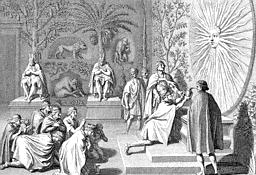
Incas praise Sun
God |
"In the reign of the
twelfth Capac, news reached Cuzco of the disembarking on the coast
of "some men of great stature.... giants who were settling the whole
coast" and, possessing metal implements, were despoiling the land.
After a time they began to go into the mountains; fortunately, they
provoked the wrath of the Great God and he destroyed them with a
heavenly fire.
"Relieved of the dangers, the people forgot the commandments and the
rites of worship. "Good laws and customs" were abandoned.... In
punishment the Creator hid the sun from the land, "there was no dawn
for twenty hours." There was a great outcry among the people and
prayers and sacrifices were offered at the temple until the sun
reappeared. The king immediately thereafter reintroduced laws of
conduct and rites of worship.
"The fortieth Capac established the study of astronomy and astrology
and determined the equinoxes. The fifth year of his reign, Montesinos calculated, was the
twenty-five hundredth from Point
Zero, which he assumed, was the Deluge. It was also the
two
thousandth year since kingship had began in Cuzco.... He (the Capac)
was granted the title of Pachacuti (Reformer)....
"In the reign of the fifty-eighth monarch, "when the
Fourth Sun was
completed," the count was 2,900 years since the Deluge. It was
Montesinos calculated, the year in which Jesus Christ was born.
"....The first Cuzco empire.... came to a bitter end in the reign of
the sixty-second monarch.... "marvels and portents" occurred, and
great battles....
"....Thus was the government of the Peruvian monarchy lost and
destroyed," Montesinos wrote, "and the knowledge of letters was
lost."
"....In the reign of the
seventy-eighth monarch, when the milestone of 3,500 years since the
Beginning was reached, a certain person began to revive the art of
writing. It was that the king received a warning from the priests
concerning the invention of letters. It was the knowledge of
writing, their message explained, that was the cause of the
pestilences and accursations that had brought kingship in Cuzco to
an end. The godís wish was "that no one ought to use the letters or
resuscitate them, for from their employment great harm would come
[again]."
Therefore the king commanded "by law, under the pain of death, that
no one should traffic in quilcas, which were the parchments and
leaves of trees on which they used to write, nor should use any sort
of letters." Instead, he introduced the use of quipus, the strands
of colour cords that has served since then for chronological
purposes.
"In the reign of the
ninetieth monarch, the fourth millennium from
Point Zero was completed. By then the monarchy at Tampu-Tocco was
weak and ineffective. In such circumstances a princess of the
original blood of the Sons of the Sun, one Mama Ciboca, rose to the
occasion. She announced that her young son, who was so handsome that
his admires nicknamed him Inca, was destined to regain the throne at
the old capital, Cuzco. In a miraculous way he disappeared and
returned clothed in golden robes, claiming that the Sun God had
taken him aloft, instructed him in secret knowledge, and told him to
lead the people back to Cuzco. His name was Rocca; he was the first
of the Inca dynasty that came to an ignominious end in the hands of
the Spaniards.
"Attempting to put these events in an orderly time frame,
Montesinos
stated at certain intervals that a period called "Sun" had passed or
begun. While what length of a period (in years) he was considering
is not at all certain, it would appear that he had in mind Andean
legends of several "Suns" in the peopleís past.
"Although scholars had held - less so nowadays - that there had been
no contact whatsoever between the Mesoamerican and South American
civilizations, the latter sound hardly different from the Aztec and
Maya notions of five Suns. Indeed, all the
Old World civilizations
had recollections of past ages, of eras when the gods reigned alone,
followed by demigods and heroes, and then just mortals.
Sumerian
texts called King Lists, recorded a line of divine lords followed by
demigods who reigned a total of 432,000 years before the Deluge,
then listed the list of kings that reigned thereafter through times
that are by now considered historical and whose data has been
verified and found accurate. The Egyptian king lists, as composed by
the priest-historian Manetho, listed a dynasty of twelve gods that
began some 10,000 years before the Deluge; it was followed by gods
and demigods until, circa 3100 B.C., the pharaohs ascended the
throne of Egypt. Again, when his data could be verified against
historical records, it was found to be accurate.
|

Inca Man
counting on a "Quipu." |
"Montesinos found such
notions in the Peruvain collective lore, confirming the reports of
other chroniclers that the Incas believed that theirs was the Fifth
Age of Sun. The First Age was that of Viracochas,
gods who were
white and bearded. The Second Age was that of the giants; some of
them were not benevolent and there had been conflicts between the
gods and the giants. Then followed the Age of Primitive Man, of
uncultured human beings. The Fourth Age was that of heroes, men who
were demigods. And there was the Fifth Age, the age of human kings,
of whom the Incas were last in line.
"Montesinos also placed the Andean chronology in the European frame
by relating it to a certain Point Zero (he thought it had to be
the
Deluge) and - most clearly - to the birth of Christ. The two time
sequences, he wrote, coincided in the reign of the fifty-eighth
monarch: the twenty-nine hundredth from Point Zero was the "first
year of Jesus Christ." The Peruvian monarchies, he wrote, began
500
years after Point Zero, i.e., in 2400 B.C.
"The problem scholars have with the history and chronology of
Montesinos is thus not lack of clarity, but its conclusion that
kingship and urban civilization began - at Cuzco -
almost 3,500
years before the Incas, that civilization, according to the
information amassed by Montesinos and those on whose work he had
relied, possessed writing, included astronomy among its sciences,
and had a calendar long enough to require its periodic reform. All
this (and more) was possessed by the Sumerian civilization that
blossomed out circa 3800 B.C. and by the Egyptian civilization that
followed circa 3100 B.C. Another offshoot of the Sumerian
civilization, that of the Indus Valley, came about circa
2900 B.C.
"....Was there a Tampu-Tocco, and was it a place identifiable by the
landmarks given by Montesinos?.... In 1911, searching for lost Inca
cities, Hiram Bingham of Yale University found the place, it is now
called
Machu Picchu.
"....After repeatedly going back and exhausting excavations over
more than two decades, he concluded that Machu Picchu was indeed the
lost interim capital of the Old Empire. His descriptions of the
place, still the most comprehensive, are in his books Machu Picchu,
a Citadel of the Incas and The Lost City of the Incas.
"The principal reason for believing that Machu Picchu
is the
legendary Tampu-Toco is the clue of The Three Windows.
Montesinos
recorded that "at the place of his birth Inca Rocca ordered works to
be executed, consisting of a masonry wall with three windows, which
were the emblem of the house of his fathers, of who he descended."
"....Machu Picchu, or Great Picchu, is the
Quichua name of a sharp
peak which rises 10,000 feet above the sea and four thousand feet
above the roaring rapids of the Urubamba River, near the bridge of
San Miguel...." Bingham wrote, "Northwest of
Machu Picchu is another
beautiful peak surrounded by magnificent precipices, called Huayna
Picchu, or Lesser Picchu....
|
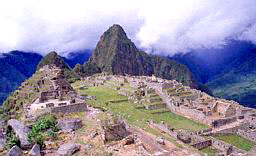
Machu Picchu
and Huayna Picchu Peaks |
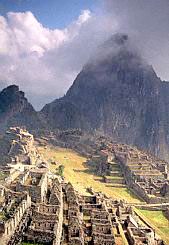 |
|

Back of
Machu Picchu Peak. |

Machu Picchu
Ruins above the Urubamba River. |
|
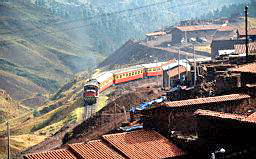
"A train
that chugs its way up, then down mountains.... tunnels
and over bridges, huggin the mountainsides flanking the
Urubamba River...." Mr. Sitchinís words.
|
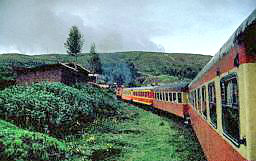
|
"As befits a city that,
we believe, at first served as a model for Cuzco and then emulated
it, Machu Picchu too consisted of twelve wards or groups of
structures.
"....the dwelling houses are built mostly of fieldstones held
together with mortar. The Royal residences are built of ashlars laid
in courses, as finely cut and dressed as any in Cuzco. Then there is
one structure where the workmanship is so perfect as to be
unmatched; and there are the polygonal megalithical stone blocks.
"....The Temple of the Three Windows (as
Bingham named it) stands on
the Sacred Plaza.... The Temple has only three walls, its western
side being completely open; there it faces a stone pillar, about
seven feet high. Bingham surmised that it might have supported a
roof, which (he admitted) would have been "a device not found in any
other building." It is our opinion that the pillar, in conjunction
with the three windows, served astronomical sighting purposes.
"Facing the Sacred Plaza on the north is the structure
Bingham named
Principal Temple; it too has only three walls, some twelve feet
high.
"....Winding steps lead from the northern age of the
Sacred Plaza up
a hill whose top was flattened to serve as a platform for the Intihuatana, a stone cut with great precision to observe and measure
the movements of the Sun. The name meant "That Which Binds the Sun,"
and it is assumed that it helped determine the solstices, when the
sun moves farthest away to the north or south, at which times rites
were held to "bind the Sun" and make it return, lest it keeps going
away and disappear, returning the Earth to a darkness that had
occurred once before according to the legends.
"At the opposite end of the sacred-royal western part of
Machu
Picchu, just south of the royal ward rises the other magnificent
(and unusual) edifice of the city. Called the Torreon for its
semicircular shape.... The semicircular wall which is reached by
seven steps, creates its own sacred enclosure at the center of which
there is a rock that has been cut and shaped and incised with
grooves. Bingham found evidence that this rock and the masonry walls
near it were subjected to periodic fires, and concluded that the rock
and the enclosure were used for sacrifices and other rituals
connected with the veneration of the rock.
"....The sanctity of the rock in
Machu Picchu stems not from its
protruding top, but from what lies below. It is a huge natural rock
inside of which there is a cave that has been enlarged and shaped
artificially to precise geometric forms that look like (but are not)
stairs, seats, ledges, and posts. Additionally, the interior has been
improved with masonry of white granite ashlars of the purest color
and grain. Niches and stone nobbins add to the interior complexity.
Bingham surmised that the original natural cave was enlarged and
enhanced to hold royal mummies, brought here because the place was
sacred. But why was it sacred, and important for depositing the
deceased kings, to begin with?
|
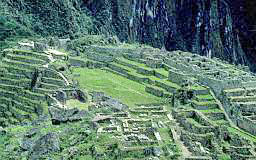
Central
Machu Picchu |
|
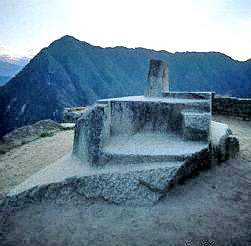
The
Intihuatana, the stone to measure the movements of the
Sun. |
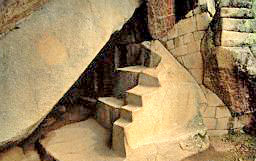
The Cave,
which lies beneath the Sacred Rock inside of the Torreon.
|
"The question takes us
back to the legend of the Ayar brothers, one of who was imprisoned
in a cave at the Haven of the Three Windows. If the Temple of the
Three Windows was the legendary one, and the cave so too, then the
legends confirm the site and the site is confirmed as the legendary
Tampu-Tocco.
"....The ninth Inca (circa A.D. 1340), "being curious about the
things of antiquity and wishing to perpetuate his name, went
personally to the mountain of Tampu-Tocco.... and there entered the
cave whence it is held for certain that Manco Capac and his brethren
came when he marched into Cuzco for the very first time.... After he
had made a thorough inspection, he venerated the place by rituals
and sacrifices, and placed doors of gold on the window of Capac Tocco and ordered that from that time onward the locality should be
venerated by all, making it a sacred prayer place for sacrifices and
oracles. Having done this, he returned to Cuzco."
"....The
ninth Inca was called Titu Manco Capac, he was given the
additional title Pachacutec ("Reformer") because after his return
from Tampu-Tocco, he reformed the calendar. So, like the
Three
Windows and the Intihuatana, the Sacred Rock and
the Torreon affirm
the existence of Tampu-Tocco, the tale of the Ayar brothers, the
pre-Inca reigns during the ancient empire, and the knowledge of
astronomy and the calendar - key elements in the history and
chronology put together by Montesinos.
"....Many South American scholars now join the early chroniclers in
believing that the natives of those lands had one or more forms of
writing in antiquity.
"...."at the start of the conquest, (Father Garcia adds), the
Indians of Peru confessed themselves by painting characters that
listed the Ten Commandments and the transgressions committed against
them." It is possible to conclude that the Peruvians
possessed the
use of a picture script, but that their symbols were courser than
the Mexican hieroglyphs and that generally the people availed
themselves of the quippus.
"Humboldt, (one of the greatest earlier explorers of South America)
reported that when he was in Lima he heard of a Missionary named
Narcisse Gilbar, who had found among the Panos Indians of the
Ucayale river north of Lima, a book of folded leaves, similar to
such as had been used by the Aztecs in Mexico; but no one in Lima
could read it. "It was said that the Indians told the Missionary
that the book recorded ancient wars and voyages."
"Writing in 1855,
Ribero and von Tschudi reported various other
discoveries and concluded that there had indeed been another method
of writing in Peru besides the quipos.... he was shown a photograph
of a skin-parchment with hieroglyphic markings. He found the actual
parchment in the Museum of La Paz, Bolivia, and made a copy of the
writing on it. He determined that the writing started at left
continuing on the second line from the right and so on, in a
serpentine manner. He also concluded that it was written at the time
when the Sun was worshipped, but that was as far as he got.
"He traced the inscription of its place of origin on the shores of
Lake Titicaca.
"Arthur Posansky (Guia general Illustrada de Tiahuanacu) found
additional inscriptions in this script on rocks on the two sacred
islands of Lake Titicaca. He pointed out that was of a kind of
enigmatic inscriptions found on
Easter Island, a conclusion with
which scholars now generally agree. But the Easter Island script is
known to belong to the family of Indo-European scripts of the
Indus
Valley and of the Hittites. A common feature to all of them
(including the Lake Titicaca inscriptions) is their "as the oz
ploughs" system: the writing on the first line begins on the left and
ends on the right; it continues on the second line beginning on the
right, ending on the left; the third line then begins on the left,
and so on.
"Without going now into the question of how did a script emulating
that of the Hittites reach Lake Titicaca, it seems that the
existence of one or more forms of writing in ancient Peru has been
confirmed. On this count too, the information provided by Montesinos
proves correct.
|
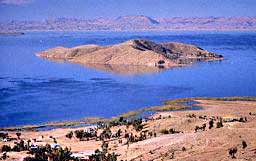
Lake
Titicaca |
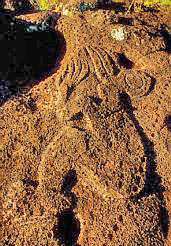
Easter
Island Birdman petroglyph |
"If in spite of all this
the reader still finds it difficult to accept the inevitable
conclusion, that there had indeed been an Old World type
civilization in the Andes circa 2400 B.C., there is additional
evidence.
"Completely ignored by scholars as a valid clue has been the
repeated statement in the Andean legends that there occurred a
frightening darkness in long-ago times. No one has wondered whether
this was the same darkness - the non appearance of the sun when it
was due - of which the Mexican legends speak in the tales of
Teotihuacan and its pyramids. For if there had indeed been such a
phenomenon, that the sun failed to rise and the night was endless,
then it would have been observed throughout the Americas.
"The Mexican collective recollections and the Andean ones seem to
corroborate each other on this point, and thus uphold the veracity
of each other, as two witnesses to the same event.
"But if even this is not convincing enough, we will call upon the
Bible in evidence, and upon none other than Joshua to be the
witness.
"According to Montesinos and other chroniclers.... "good customs
were forgotten and people were given to all manner of vice," that
"there was no dawn for twenty hours." In other words, the night did
not end when it usually does and sunrise was delayed for twenty
hours. After a great outcry, confessions of sins, sacrifices, and
prayers, the sun finally rose.
"This could not have been an eclipse: it was not that the shining
sun was obscured by a shadow. Besides, no eclipse lasts so long, and
the Peruvians were cognizant of such periodic events. The tale does
not say that the sun disappeared; it says that it did not rise -
"there was no dawn" - for twenty hours.
"It was as though the sun, wherever it was hiding,
suddenly stood
still.
"....Scholars have struggled for generations with this tale in
Chapter 10 of the Book of Joshua.
"The incident, whose uniqueness is recognized in
the Bible ("There
was no day like that before or after"), taking place on the other
side of the Earth relative to the Andes, thus describes a phenomenon
that was the opposite of what had happened in the Andes. In
Canaan the sun did not set for some twenty hours; in
the Andes, the sun did
not rise for the same length of time.
"Do not the two tales, then, describe
the same event, and by coming from different sides
of the Earth attest to its factuality?.
"What the occurrence was is still a puzzle. The
only biblical clue
is the mention of the great stones falling from the skies. Since we
know that the tales do not describe a standstill by the sun (and
moon) but a disruption of Earthís rotation on its axis, a possible
explanation is that a comet had come too close to Earth,
disintegrating in the process. Since some comets orbit the sun in a
clockwise direction that is opposite to the orbital direction of the
Earth and the other planets, such a kinetic force could have
conceivably counteracted temporarily the Earthís rotation and slowed
it down.
Mr. Sitchin explains at this point the timing of the legends,
biblical and Andean, coinciding with the legend from
Teotihuacan.
"The hard-hitting conclusion is clear:
THE DAY THE SUN STOOD STILL IN CANAAN WAS THE NIGHT WITHOUT
SUNRISE IN THE AMERICAS.
"The occurrence, thus verified, stands out as irrefutable proof of
the veracity of Andean recollections of an Ancient Empire that began
when the gods granted Mankind the golden wand at Lake Titicaca.
|
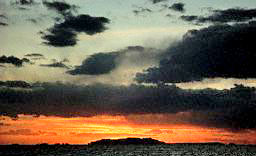
Sunset on
Lake Titicaca |
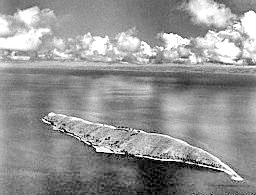
Island of
the Moon. Lake Titicaca. |
Return
Chapter Eight
THE WAYS OF
HEAVEN
"Thus did the biblical Psalmist describe the marvels of the heavens
and the miracles of days and nights following each other, as the
Earth rotates in its axis (the biblical "line" that goes through the
Earth) and orbits the Sun that sits at the center of all (as a
potentate in his tent)....
"....For millennia, ever since
Man acquired civilization
astronomer-priests looked to the heavens for guidance for Man on
Earth - from the Ziggurats of Sumer and
Babylon, the temples of
Egypt, the stone circle of Stonehenge or the
Caracol of Chichen Itza.
Complex celestial motions of the stars and planets have been
observed, calculated, recorded; and to make that possible, the
ziggurats and temples and observatories were aligned to precise
celestial orientations and provided with apertures and other
structural features that let the light of the sun or another star
enter as a beam at equinox or solstice times.
|

Ancient
ruins of Ur, (ancient Sumer), modern day Iraq. Remains
of Ziggurat at far left. |
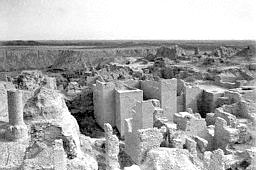
Ancient
ruins at Babylon, modern day Iraq |
|
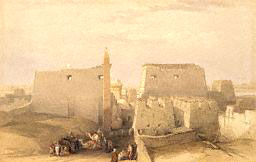
Grand
Entrance to an Egyptian Temple at Luxor |
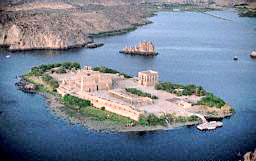
Egyptian
Temples south of Aswan |
|
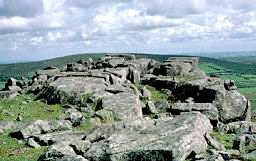
The Welsh
hill where the massive Stonehenge stones came from.
|
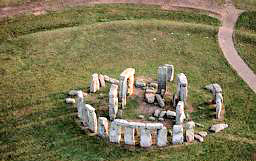
Stonehenge,
where the Solstice was observed |
|
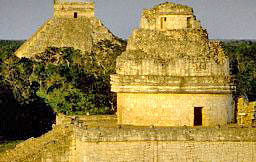
El Caracol
Observatory, Mayan, Chichen Itza. |

|
"....A farmer tilling
the land year after year can judge the change of seasons and the
coming of rains better than an astronomer, and has the groundhog to
tell him a thing or two. The fact is wherever pockets of primitive
societies (subsisting on agriculture) have been found in remote
parts of the world, they have lived and fed themselves for
generations without astronomers and a precise calendar. It is also
an established fact that the calendar was devised in antiquity by an
urban, not an agricultural, society.
"....Yet ancient man studied the heavens and aligned his temples
toward stars and planets, and linked his calendar and festivals not
to the ground upon which he stood but to the ways of heaven. Why?
Because the calendar was devised not for agricultural but for
religious purposes. Not to benefit mankind but to venerate the
gods.
And the gods, according to the first-ever religion and the people
who gave us the calendar, came from the heavens.
"....It was knowledge, the
Sumerians asserted, that was given them
by the Anunnaki ("Those Who from Heaven to Earth Came") who had come
to Earth from their planet, Nibiru. Nibiru, they said, was the
Twelfth member of the Solar System, and that is why the celestial
band was divided into twelve houses, the year into twelve months.
Earth was the seventh planet (counting from the outside in) and
therefore as twelve was a hallowed celestial number, seven was a
sacred terrestrial one.
"The Anunnaki, the
Sumerians wrote upon numerous clay tablets,
had
come to Earth long before the Deluge. In The 12th Planet we
determined that it happened 432,000 years before the Deluge - a
period equivalent to 120 orbits of Nibiru.... equivalent to 3,600
Earth-years per orbit.... and there is no doubt whatsoever that the
Sumerians began to observe the heavens not to know when to sow, but
in order to see and celebrate the return of the celestial Lord.
"This, we believe, is why Man became an astronomer.
This is why, as
time passed and Nibiru could no longer be observed, Man sought signs
and omens in the phenomena that could be seen, and astronomy bred
astrology. And if the astronomical orientations and alignments and
celestial division that began in Sumer could also be found in
the
Andes, an irrefutable link would be proven.
"....The care and great astronomical knowledge that were required
for building temples in Sumer are evident from the Inscriptions of
the Sumerian King Gudea (circa 2200 B.C.). First there appeared to
him "a man who shone like the heaven" who "was standing beside a
"divine bird." This being, Gudea wrote, "who by the crown on his
head was obviously a god," turned out to have been the god
Ningirsu.
He was accompanied by a goddess who "held the tablet of her
favorable star of the heavens." In her other hand she held "a holy
stylus" with which she pointed out to the king "the favorable
planet." A third human looking god held in his hands a tablet made of
precious stone, on which the plan of the temple was drawn.... And it
was, the text indicates not a Solar but a Star + Planet Temple.
|
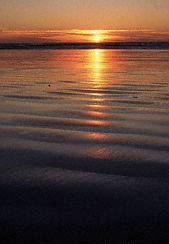
Sun at Horizon.
|
"....It was in
Sumer
that all the concepts and principles of modern spherical astronomy
were laid out. The list can begin with the division of a circle into
360 degrees, the devising of zenith, horizon and other astronomical
concepts and terminologies, and end with the grouping of stars into
constellations, the devising, naming, and pictorial depiction of the
zodiac and its twelve houses, and the recognition of the
phenomenon
of Precession - the retardation, by about one degree every
seventy-two years, of Earthís motion around the sun.
"....After the phenomenon of day and night the easiest to recognize
are the seasons. As the simplest and abundant stone circles attest,
it was easy to establish markers delineating the four points in the
Earth/Sun relationship:
"....the Sunís apparent rising higher in the skies and lingering
longer as winter gives way to spring; a point when day and night
appear equal; the gradual distancing of the sun as days grow shorter
and the temperature begin to drop. As cold and darkness increase and
it seems that the Sun may vanish all together, it hesitates, stops
and begins to comeback; and the whole cycle is repeated - a new year
has begun. Thus were the four occurrences in the Earth/Sun cycle
established: íthe summer and winter solstices ("solar standstills")
when the sun reaches its outermost positions north and south, and
the spring and autumn equinoxes (when day and night are equal).
|

Stone Circle
at Cuzco. |

Stonehenge
at right as Sun sets. |
"....It was necessary to
provide the observer on Earth with a celestial point of reference.
This was achieved by dividing the heavens, the great circle formed
by the Earth going around the Sun, into twelve parts - the
twelve
houses of the Zodiac, each with its own group of discernible stars (
the constellations).
"....Because Earthís axis is inclined in relation to its orbital
plane around the Sun (23.5 degrees nowadays) and it spins as a top,
forming a great imaginary circle in the heavens that takes 25,920
years to complete, that means that the selected "fixed point,"
shifting one degree every 72 years, shifts completely from one
zodiac house to another every 2,160 years. Some two millennia after
the calendar was begun in Sumer, it was necessary to order a reform
of the calendar and select as the fixed point the House of Aries.
Our astrologers still chart their horoscopes based on the First
Point of Aries, although our astronomers know that we have been
almost two thousand years in the Age of Pisces (and are about to
enter the Age of Aquarius).
"....By Baylonian times, in the second millennium B.C.,
temples
required a triple alignment:
-
to the new zodiac (Aries)
-
to the
matching four solar points (the most important of which, in Babylon,
was the spring equinox)
-
to the lunar period
The principal
temple of Babylon honoring its national god Marduk, the remains of
which have been found in good preservation, exemplifies all these
astronomical principles.
|
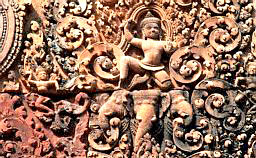
God Indra on a
three headed Elephant. |
"....That
astronomy,
combined with archaeology, can help date monuments, explain
historical events, and define the celestial origins of religious
beliefs, has been recognized fully only in recent years.
This discipline is today known as
archaeoastronomy.
"....In 1894,
Sir Norman Lockyer noted.... "a remarkable thing: in
Babylon, from the beginning of things, the sign for God was a star";
likewise, in Egypt, "in the hieroglyphic texts, three stars
represented the plural ígods.í" He also noted that in the
Hindu
pantheon, the most venerated temple gods were Indra ("The Day
Brought by the Sun") and Ushas ("Dawn"), gods related to the rising
of the Sun.
"....Lockyer recognized that temples in antiquity were
Sun Temples
or Star Temples. The former were temples whose axis and ritual or
calendric functions aligned them with either the solstices of the
equinoxes; the latter were temples not connected with any of the
four Sun points, but designed to observe and venerate the appearance
of a certain star on a certain day at a certain point on the
horizon. Lockyer found it amazing that the older the temples were,
the more sophisticated their astronomy had been.
|

El-Karnak,
in ancient Egyptian capital Thebes |
|
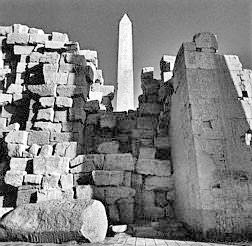
Obelisk
beyond Temple of Karnak
|
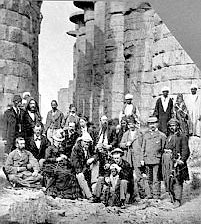
A bit more
recent!
A group of people sitting at the foots of the columns of
the Great Temple to Amon-Ra, Karnak |
"His mayor example (Lockyerís),
was the complex of Temples at Thebes in Upper Egypt (Karnak). There
the older, more sophisticated orientation of the earliest sacred
cities (to the equinoxes) had given way to the easy orientation
toward the solstices. At Karnak the Great Temple to Amon-Ra
consisted of rectangular structures build back-to-back on an
east-west axis with a southern tilt. The orientation was such that
at solstice time a beam of sunlight would travel the whole length of
a corridor (some five hundred feet long), passing from one part of
the temple to the other between two obelisks, and for two minutes
the sunbeam would strike the Holy of Holies with a flash of light at
the far end of the corridor, thereby signaling the moment when the
first day of the first month began the new year.
"But that precise moment
was not constant; it kept shifting,
resulting in the construction of subsequent temples with modified
orientations.... Over time, the Sunís movements seemed subject to
yet another phenomenon in the Earth/Sun relationship, this was the
discovery by astronomers that the Earthís obliquity, the tilt of its
axis against its orbital path around the Sun, has not always been
its present one....
The point Mr. Sitchin makes by giving all these astronomical details
(more in his book) is, that it gives indication of the times the
ancients built their Sun and Stars Temples, and observatories.
Rolf
Muller applies the Earth/Sun relationship to Andean archaeology,
coming to the conclusion that such buildings were built at least
4,000 years ago.
"....Such application of
archaeoastronomy to Andean remains, as we
shall see, has upset even more notions regarding the antiquity of
civilization in the Americas.
"Modern astronomers were slow to come to
Machu Picchu, but eventually
they did....
"At Machu Picchu
Muller focused his attention on the Intihuatana....
he realized was placed atop the highest point of the city. It could
command a view of the horizon in all directions, but walls of
megalithic ashlars confined the view to only certain directions,
ones that were in the mind of the builders.... Muller determined
that the various inclined surfaces and angled sides were so devised
as to enable the determination of sunset at the summer solstice,
sunrise at the winter solstice, and of the spring and autumn
equinoxes.
|
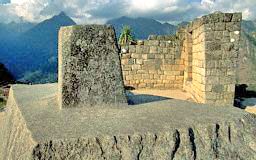
INTIHUATANA
|
 |
"....An old Spanish
woodcut suggested to Muller that the great Temple of the Sun at Cuzco was so constructed as to allow the sunís rays to shine
directly into the Holy of Holies at the moment of sunrise on the day
of winter solstice. Applying the theories of Lockyer to the
Coricancha, Muller was able to calculate and to show how the
pre-Columbian walls together with the circular Holy of Holies were
able to serve the same purpose as the temples of Egypt.
"....In the 1980ís two astronomers from the Steward Observatory,
University of Arizona, D.S. Dearborn and R. E. White (Archaeoastronomy
at Machu Picchu) went over the same ground with more precise
instruments.... they did not join, however, in Mullerís discussion
of the structureís age.... Neither they nor Muller attempted to
trace back, to millennia ago, the lines of observation through the
most ancient megalithic structure, the legendary Three Windows.
There, we believe, the results would have even been more astounding.
"Muller did, however, study the orientation of the megalithic walls
in Cuzco. His conclusion, whose far-reaching implications have been
ignored, was that "they are positioned for the era of 4000 B.C. to
2000 B.C...."
This puts the age for the megalithic structures (at
Cuzco,
Sacsahuaman, and Machu Picchu, at least) in the 2000- year period
preceding the 2000 B.C. of the Torreon and Intihuatana at
Machu
Picchu.... Muller concluded that the structures form the pre-Inca
period stretch over two zodiac ages: the megalithic ones belonging
to the Age of Taurus; the ones from the times of the Ancient Empire
and the hiatus at Tampu-Tocco being from the Age of Aries.
"In the ancient Near East the
shift caused by precession required
periodic reform of the original Sumerian calendar. A major change,
accompanied by major religious upheavals, took place circa 2000 B.C.
with the transition from the zodiac of the Bull to that of the
Ram.
To othersí (but not our own) amazement, such changeovers and reforms
are also evidenced in the Andes.
"....It took however several studies, beginning in the 1930s, to
confirm that these people not only had a calendar but also recorded
it (though they were supposed to have no writing). A pioneer in the
field, Fritz Buck, produced archaeological evidence to support such
conclusions, such as a mace that was a time-reckoning instrument
and a vase, found in the ruins of the temple of Pachacamac, that
denoted four periods of twelve with the aid of line and not markings
akin to those of the Maya and Olmecs.
"....Because the
Gregorian calendar was introduced in Cuzco only
after Molinaís time, the day of the New Year related by him
corresponds to May 25 or thereabouts. Observation towers that had
been described by Garcilaso have been discovered in recent years by
astronomers from Texas and Illinois.... According to the
chroniclers
the Incas considered their year to begin in the winter solstice
(equivalent to the summer solstice in the northern hemisphere). But
this event occurs not in May, but on June 21.... a difference of a
full month.
"The only plausible explanation for this can come from a recognition
that the calendar and the system for observation on which it was
based was bequeathed to the Incas from an earlier Age; a retardation
by one month results from the precessional shift that lasts 2,160
years per zodiac house.
"....Reports (from chroniclers and researchers such as
L.E. Valcarel)
tell that the Incas went to great lengths to determine the precise
days of the equinoxes and venerated them. This custom must have also
stemmed from earlier times, for we read in the early reports that
the monarchs of the Ancient Empire were preoccupied with the
need to
determine the equinoxes.
"....What was happening circa 400 B.C. that required a reform of the
calendar? The length of the time span 2000 years, parallels the time
spans of zodiacal shifts due to precession. In the ancient Near
East, when the calendar was begun at Nippur, circa 4,000 B.C., the
spring equinox occurred in the House or Age of Taurus. It retarded
to that of Aries circa 2,000 B.C. and to Pisces by
Christís time.
"The Andean reform circa 400 B.C. confirms that the ancient empire
and its calendar indeed began circa 2500 B.C. It also suggests that
those monarchs were familiar with the zodiac; but the zodiac was a
purely artificial and arbitrary division of the celestial band
around the Sun into twelve parts; a Sumerian invention that had been
adopted in the Old World by all the people who had succeeded them
(to this very day). Was this possible? The answer is yes.
"....The names ( of the zodiac), to scholarsí surprise, but not to
ours, bear an uncanny resemblance to the ones with which we are all
familiar and which originated in Sumer. Thus:
-
January, the month of
Aquarius, was dedicated to Mama Cocha and
Capac Cocha, Mother Water and Lord Water.
-
March, the month of
Aries when the first moon signified in antiquity
New Yearís eve was called Katu Quilla, Market Moon.
-
April,
Taurus, was named Tupac Taruka, Pasturing Stag (there were no
bulls in South America).
-
Virgo was
Sara Mama (Maize Mother) and its symbol was the female
member, and so on.
"Indeed, Cuzco itself was a testimonial in stone both to the
familiarity with the twelve-house zodiac and the antiquity of that
knowledge.
"....One must wonder whether the knowledge required for such
astronomical information and calendar reforms could have been
retained and passed along over so many millennia without some kind
of record-keeping, without being written down in some form. The Maya
codices contained, as we have seen, astronomical data copied and
obtained from earlier sources.
"...."Primitive"
calendar-zodiac circular stones must have preceded
the perfected Aztec "calendar stones," several of which have been
found and a golden one of which, the most hallowed of all, was
presented to Cortes by Moctezuma when the latter believed that he
was only returning to the God of the Plumed Serpent what was his.
|
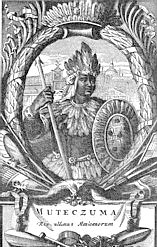 |
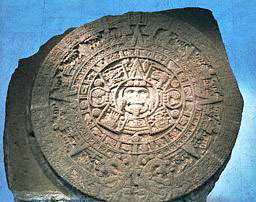
Round Stone
found at Tikal. Image of the Sun God is surrounded by
celestial glyphs. Maya. |
"Were there such records
- in gold - in existence in ancient Peru?.... At least one such
relic remains.
It is a golden disk, about 5 1/2 inches in diameter. Discovered in
Cuzco and now lodged in the Museum of the American Indian in New
York.
There were several interpretations of what the disk signified....
"None (scholars) have shown, however, how similar it is to the
calendar discovered at Tikal - perhaps because it would add another
nail to the coffin in which the notion that there had been no
contact,
no "diffusion" between Mesoameria and South America,
must be laid
to rest.
"....The physical destruction (of the Spanish force) could not
eradicate what the Incas retained in their memories. The
Coricancha
was built, the Incas recalled, by the very first monarch; it began
as a hut with a thatched roof. Later monarchs enlarged and enhanced
it, until it assumed the final dimensions and shape as seen by the
Spaniards. In the Holy of Holies, they related, the walls were
covered from floor to ceiling with plates of gold....
"....The most detailed description of the centerpiece (in the
Holy
of Holies).... was provided by Salcamayhua: it was the first king of
the Inca dynasty who "ordered the smiths to make a flat plate of
gold which signified that there was a creator of heaven and earth."
Salcamayhua illustrated his text with a drawing: it was the unusual
and rare shape of an oval.
"That first image was replaced by a round plate when a certain
monarch later declared the Sun supreme. It was changed back to an
oval image by a subsequent Inca "a great enemy of idols; he ordered
his people not to pay honors to the Sun and Moon"; rather, to the
celestial body represented by the oval shape; it was he who had
"caused images to be put around the plate." Referring to
the oval
shape as "The Creator," Salcamayhua made it clear that
it did not
mean the Sun, for the images of the Sun and the Moon had flanked the
oval. To illustrate what he meant, Salcamayhua drew a large oval
flanked by two smaller circles.
"....Inca Huascar, one of the two half brothers involved in the
struggle for the throne when the Spaniards arrived, he removed the
oval image and replaced it "with a round plate, like the Sun with
rays." "Huascar Inca had placed the image of the Sun in the place
where the Creator had been."
"....Explaining that the gabled wall with the oval as its principle
image represented "what the heathen thought" regarding the heavens
and the earth, Salcamayhua drew a large sketch showing how the wall
had looked before Huascar replaced the oval shape with the Sunís
image. (By this, Huascar also adding to his name the epithet
Inti
("Sun") meaning that it was he, and not his half brother, who was
the true offspring of the original Sons of the Sun). The sketch has
survived because Francisco de Avila.... kept it among his papers. He
also scribbled on and around the sketch notations explaining the
images, using the Quechus and Aymara terms given by the natives and
his own Castillian Spanish. When these notations are removed one
gets a clear picture of what had been depicted above the altar.
Following are guidelines,
Mr. Sitchin goes to more detail in his
book:
long crisscrossed object at the bottom;
terrestrial symbols: people, an animal, a river, mountains, a lake,
etc. at the bottom part;
celestial images: Sun, Moon, stars, the
enigmatic oval, etc. in the
upper part.
"....Markham saw in the upper part "a stellar chart which is a
veritable key to the cosmogony and astronomy of ancient Peru," and
was certain that the gabled triangular tip was a hieroglyph for
"sky." S.K. Lothrop (Inca Treasure) stated that the images above the
great Altar "formed a cosmogony tale of the creation of heaven and
earth, the Sun and Moon, the first Man and Woman." All are agreed
that Salcamayhua had stated, it represented "what the heathens
thought" - the sum total of their religious beliefs and legendary
tales; a saga of Heaven and Earth and the bond between them.
"....Since the
Sun was thus depicted (to the left of the oval), what
did the central image, the great oval, represent? The tales describe
how this symbol alternated with the Sun in being worshipped and
venerated in Inca times. Its identity is clearly explained by a
notation that reads, "Illa Ticci Uuiracocha, Pachac Acachi. Quiere
decir imagen del Hacedor del cielo y de la tierra." Translated, it
means "Illa Ticci Viracocha, Maker of All; that is to say, image of
the Creator of Heaven and Earth."
"But why was
Viracocha depicted as an oval?
"One of the principal researchers of the subject,
R. Lehmann-Nitsche....
developed the thesis that the oval shape represented the "Cosmic
Egg," a theogonic idea that is echoed in Greek legends, in Hindu
religions, "even in Genesis." It is the oldest theogony whose
details have not been grasped by white authors." It had been
represented in the sanctuaries of the Indo-European deity Mithra as
an egg surrounded by the constellations of the zodiac. "Perhaps one
day Indianologists will see the similarities in the details and cult
of Viracocha, Brahma with the seven eyes, and the Israelite
Yahweh.... In the classic antiquity and in the Orphic cult were
sacred images of the Mystic Egg; why shouldnít the same happen in
the great sanctuary of Cuzco?
"....But he (Lehmann-Nitsche) and others seem to ignore the fact
the
elliptical shape has superimposed on it (at the bottom) a star
symbol. If, as it seems, the elliptical or oval shape applies to one
more celestial body (besides the five above and four below), it
spells to us the "oval" that is found in nature -
not on Earth, but
in the heavens: it is the natural curve of a planetís orbit around
its sun. It is we suggest, the orbital path of a planet in our Solar
System.
"What the sacred wall depicted, we must conclude, was not distant or
mysterious constellations, but our own Solar System, with the Sun,
the Moon, and ten planets, adding up to a total of twelve.... The
two groups (of celestial bodies) are divided by the vast elliptical
orbit of the twelfth member of the Solar System. To the Incas, it
represented the celestial Viracocha.
"Should we be surprised to find that
this was exactly the Sumerian
view of our Solar System?
Mr. Sitchin explains more at length (in his book) other symbols
found on the depiction, like:
In the skies:
a starry sky, depicts bright nights in "summer";
clouds, depict "winter";
fierce animal under clouds, represents a zodiac sign for winter
"Leo,"
which is unusual because there are no lions in South America;
a star under the starry sky, represents the solstice (then) when the
Sun was seen in the zodiac constellation of the Lion (UR.GULA in
Sumerian).
And on Earth:
the first Man and Woman, Eden, a large river, a serpent, mountains,
a sacred lake. An Incan "panorama of the world," in the words of
Lehmann-Nitsche. It would be more accurate to say, the
Pictorial
Bible of the Andes.
"....The elements in this part of the pictorial composition could
well serve to illustrate the Mesopotamian-biblical tales of Adam and
Eve in the Garden of Eden.... The Sumerian E.DIN (from which Eden
stems) was the valley of the great river Euphrates, emanating from
the high mountains in the north. This geography is clearly depicted
on the wallís right, where a globe representing Earth bears the
notation "Pacha Mama" - Mother Earth. Even the
Rainbow which
featured in the Near Eastern tales of the Deluge, appears here.
" (While all accept that the globe or circle marked
Pacha Mama
represents the Earth, none have stopped to wonder how the Incas knew
that the Earth was round. The Sumerians, however, were aware of the
fact and depicted the Earth and all the other planets accordingly).
"The group of seven dots below the Earth (in the Inca depiction) has
given scholars endless problems.... adhering to the erroneous
notions of the Pleiades.... that portion of the constellation
Taurus.... "the seven eyes of the supreme god...." But we have
already shown that the seven dots, the number seven, was the
designation of Earth itself in the Sumerian enumeration of the
planets. The symbol "seven" is thus exactly where it belongs, as a
caption for the globe of the Earth (rather than at the top or bottom
of the depiction).
The last image on the sacred wall is that of a great lake connected
by a waterway to a smaller body of water. The notation on this is
"Mama Cocha," Mother Water. All are agreed that this represents
the
Andean sacred lake, Lake Titicaca, by depicting it, the Incas had
taken the story of Creation from the Heavens to Earth and from
the
Garden of Eden to the Andes.
"Lehmann-Nitsche summed the meaning and message of the composite
depiction on the wall above the Great altar by saying, "it takes man
from the ground to the stars." It is doubly amazing that it takes
the Incas to the other side of the Earth.
Return
|
































